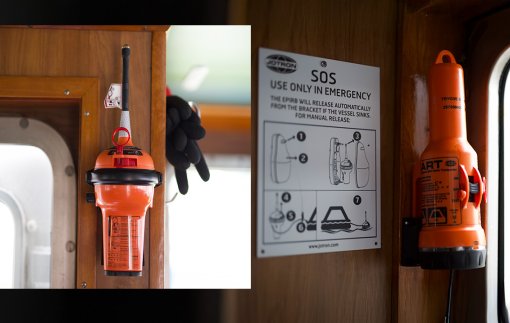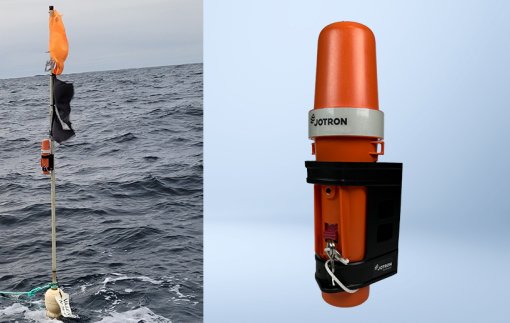A Voyage Data Recorder (VDR) float-free capsule - purpose and functions
A Voyage Data Recorder float-free capsule is a crucial component of a ship's VDR system, comparable to an aircraft's "black box."

The purpose and functions of a VDR float-free capsule
A VDR system have 3 different storage modules as part of the VDR specifications:
-
The long storage module in the VDR computer
-
The fixed storage module fitted onto the vessel’s deck
-
The float free storage module
A VDR is built to capture and store a range of data from a ship’s voyage, such as navigational information, bridge voice recordings, and other essential operational details.
In the event of an accident, this data provides valuable insight into the incident, supporting investigations and improving safety measures moving forward.
Float-free capsule
The float-free capsule is a protective and buoyant capsule, designed as a combine Emergency Position Indicating Radio Beacon (EPIRB) with a VDR storage module. The float free capsule is following either the VDR test standard IEC 61996-1 Ed 2014 or the Ed 2021, according to either the EPIRB performance standard A.810(19) or the MSC.471(101).
In the event of a sinking or major accident, the capsule automatically separates from the ship and floats to the surface, ensuring the recorded data can be retrieved.
Key features
Automatic release: The capsule is designed to automatically release and float to the surface if the ship sinks, but it should be positioned where the crew can access and retrieve it before evacuating the vessel.
Durability: It is designed according to an EPIRB test standard with reference to IEC 61097-2 Ed3 or Ed 4.
Buoyancy: The capsule is designed to be highly buoyant, allowing it to remain on the water's surface, making it easy for rescue teams to locate and retrieve.
Signal transmission: The float-free capsule designed according to IEC 61996-1: 2014 or 2021, transmit the same signals as an EPIRB (406MHz, 121.5 MHz-homing, and the newest capsules transmit an Automatic Identification System (AIS) homing). In addition, the float free capsule uses Global Navigation Satellite System (GNSS) technology such as the Global Positioning System (GPS) and features a visual light-emitting diode (LED). The latest float-free capsule is equipped with an infrared LED and, in some models, offers Return Link Service (RLS) via the Galileo satellite system. A VDR float-free capsule can operate for 168 hours, significantly longer than a standard EPIRB, which functions for 48 hours in temperatures as low as -20°C.
Regulatory compliance
Mandatory equipment: International maritime regulations, such as those enforced by the International Maritime Organization (IMO), require VDR system installed on vessels under the SOLAS Convention from + 3000GT. National regulations also require VDR installed on vessels sailing in domestic water and on ferries (RO/RO).
Risk management
Accident investigation: Data recovered from a VDR float-free capsule can be crucial for determining the causes of maritime accidents, aiding in the prevention of future incidents and improving overall safety standards.
Insurance: Equipping a VDR with a float-free capsule may help lower insurance premiums, as it demonstrates a strong commitment to safety and regulatory compliance.
Operational efficiency
Safety improvements: Insights gained from analyzing VDR data can lead to enhancements in ship operations and crew training, thereby improving overall operational efficiency and safety.
Crisis management: In the event of an incident, quick access to VDR data can facilitate effective crisis management and response, minimizing downtime and operational disruptions.
Cost and maintenance
Initial investment: Acquiring and installing a VDR with a float-free capsule involves a significant initial investment.
Maintenance: Regular maintenance, testing, and certification are essential to ensure the system’s reliability and compliance with safety standards. The VDR system is subject to annual performance tests (APT), while the float-free capsule is governed by combined maintenance regulations, as it functions both as an EPIRB and a storage module device.
VDR float free maintenance: In the MSC.1/Circ.1222 and under chapter 2.7 it clearly states: “…confirmation that the capsule float-free arrangements, where required or fitted, are satisfactory as originally accepted at commissioning; and that any battery, release mechanism or other datable items are within their expiry date. In addition, for float-free capsules approved in accordance with resolution MSC.333(90), the examination should be carried out in accordance with MSC.1/Circ.1040/Rev.1; and….”
Further to the above and according to the MSC.1/Circ.1040/Rev.1 or Rev.2 and chapter 4.13 it clearly states, “…verifying that the EPIRB has been maintained by an approved shore-based maintenance provider at intervals required by the Administration, in accordance with the most recent revision of MSC/Circ.1039”.
The MSC/Circ.1039 and 1039/Rev.1 require any EPIRB which comply to EPIRB performance standard A.810(19) or MSC.471(101) to meet shore-based maintenance and according to chapter 4.2 “Shore-based maintenance of all EPIRBs, as defined in paragraph 1.2, should be carried out in accordance with these Guidelines at intervals specified by the flag State Administration and not exceeding five years.”
A VDR system including the VDR float-free capsule is a vital safety and compliance tool for maritime operations. It ensures that critical voyage data is preserved and retrievable in the event of an accident, supporting effective investigations and continuous safety improvements.




